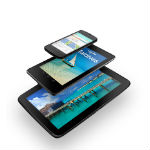 The advent of the tablet and faster, more feature-rich smartphones has mobile network operators scrambling to come up with ways to meet seemingly ever growing mobile data demand. Yet, while growth in demand for mobile data has been “explosive,” a tiny slice of 3G and 4G service subscribers around the world account for an overwhelmingly large share.
The advent of the tablet and faster, more feature-rich smartphones has mobile network operators scrambling to come up with ways to meet seemingly ever growing mobile data demand. Yet, while growth in demand for mobile data has been “explosive,” a tiny slice of 3G and 4G service subscribers around the world account for an overwhelmingly large share.
Expanding its research coverage to include multiple developed and developing markets making use of 3G and 4G networks, JDSU’s Location Intelligence Business Unit found that for the past two years running just 1% of 3G network subscribers account for 50% or more of mobile data demand. Multiply that by 10 for 4G network subscribers: just 0.1% of 4G users consume more than 50% of all LTE downlink data, according to the JDSU unit’s fourth annual “Extreme Mobile Data Usage” report.
“For the past three years we’ve seen explosive growth in mobile data usage, causing operators to have to wrestle with the challenges their success is creating,” report author and CTO of Mobility for the Network and Service Enablement segment of JDSU Dr. Michael Flanagan was quoted in a press release.
“The faster the speeds that mobile operators provide, the more consumers swallow it up and demand more. “One would expect a honeymoon period in which early adopters test their toys. But for 4G users to consistently exhibit behavior 10 times more extreme than 3G users well after launch constitutes a seismic shift in the data landscape. This has important ramifications for future network designs.”
And it seems that not all devices are created equal when it comes to mobile users’ data demand. With the successive launches of the iPhone 4, 4S and 5, Apple smartphone users for the past three years have proven themselves the most voracious consumers of mobile data. iPhone 5s users, for their part, download 7x as much as users of the benchmark iPhone 3G in developed markets, 20% more than iPhone 5 users. That rises to 20x for iPhone 5S users in developing markets, 50% above iPhone 5 users.
After a year in which downloads by Samsung Galaxy S III users indicated a possible end to Apple iPhone users’ dominance, the iPhone 5s topped both JDSU’s developed and developing market mobile data usage charts. In fact, iPhone 5s usage in this year’s survey was “the most intense witnessed to date,” according to JDSU. Overall, six of JDSU’s top 10 hungriest smartphone handsets were Apple devices.
“Each new generation of iPhone has resulted in increases in data consumption of between 20-40 percent – even today when data use is common,” Flanagan commented. “Though interestingly, users of the more economically-priced iPhone 5c consume data in the range between that of the iPhone 4s and 5 users.”
The story is similar when it comes to tablet mobile data usage. Fourth-generation iPad users have been consuming more mobile data than users of any other tablet, from Apple or otherwise. They consumed nearly 40% more data than the Samsung Galaxy Tab 2.10.1, which topped JDSU’s rankings in 2012.
The new iPad mini is proven to be “mini” when it comes to mobile data usage, however. Users have been consuming 20% less mobile data than users of the second and third-generation iPads.
“Last year, we were surprised to see that smartphones trumped tablets when it came to data consumption. Lost ground has not been made up by tablets, in spite of the progress of the fourth generation iPad. Only two of our top ten most hungry devices were tablets this year, compared to three last year,” Flanagan elaborated.
Though smartphone data usage rankings were similar across both developed and developing markets, JDSU researchers found that “the number and variety of data cards and dongles was lower in developing markets, and tablet devices relatively rare.” These differences may account for higher rates of smartphone data consumption by flagship smartphone users in developing markets, according to JDSU.
The extreme skewing revealed by JDSU’s annual studies suggest possible means by which mobile telecom service providers can cope with burgeoning data demand. “For example,” Flanagan elaborated, “the fact that 0.1 percent of 4G subscribers consume half of the data may prompt operators to identify extreme users. This, in turn, may make it easier to deploy small cell and Wi-Fi access points to ease network congestion. However, the accuracy of these placements should be of paramount importance to operators due to the limited range of the small cells and Wi-Fi.
“This is likely part of an overall trend towards the ‘personal’ wireless network. Just as femtocells were placed in homes to satisfy network coverage objectives on a subscriber-by-subscriber basis, small cells and Wi-Fi access points may be placed to satisfy network capacity objectives on a subscriber-by-subscriber basis.”


